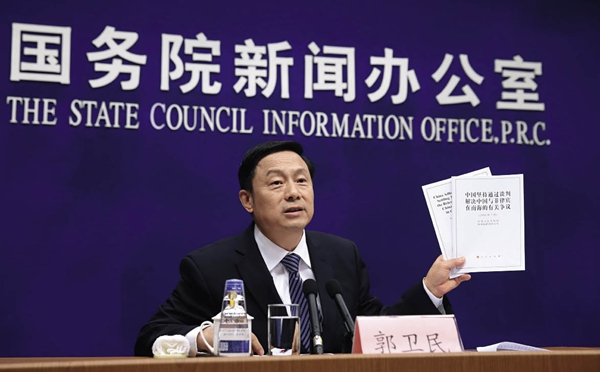By LIN MINWANG
By LIN MINWANG
IN January 2013, the then government of the Republic of the Philippines unilaterally initiated the South China Sea arbitration. This violated the standing agreement with China to settle the relevant disputes through bilateral negotiation. It also violated China’s right as a state party to the United Nations Convention on the Law of the Sea (UNCLOS) to choose the means of dispute settlement. This action hence constituted wanton abuse of the UNCLOS dispute settlement procedures. In so doing, the Philippines has attempted to deny China’s territorial sovereignty and maritime rights and interests in the South China Sea.

The Chinese government unveiled the white paper on July 13 to reaffirm its stance on the South China Sea disputes.
Chinese President Xi Jinping reaffirmed in his remarks the Chinese government’s stance with regard to the award rendered on July 12, 2016 by the Arbitral Tribunal in the South China Sea arbitration established at the unilateral request of the Philippines, and the Chinese government issued a statement on China’s sovereignty in the South China Sea and related maritime rights and interests. China’s Foreign Ministry also issued a statement on the award, pointing out that it is “null and void and has no binding force.” The statement confirmed that China neither accepts nor recognizes the award.
China’s Stance Complies with International Law and Jurisprudence
China is entirely justified in its non-acceptance of the arbitration, and its stance is lawful and legitimate. As to the issues of territorial sovereignty and maritime rights and interests, China will never accept any solution of unilaterally appealing to a third party to resolve disputes.
As to the main reasons why the Chinese government does not accept the arbitration, they can, from the perspective of international law, be set down as follows: First, China and the Philippines have already signed a collection of bilateral agreements, notably the joint declaration and joint communiqué in which they agreed to resolve disputes via negotiations.
Second, China and the ASEAN countries, including the Philippines, signed in 2002 the Declaration on Conduct of Parties in the South China Sea (DOC). Paragraph 4 of the DOC clearly stipulates that relevant disputes should be addressed by the parties concerned through consultations and negotiations. The above two reasons constitute the “agreement” between China and the Philippines on resolving the South China Sea disputes through negotiations. The Philippines’ initiation of arbitration thus violated international law and the basic principle of international law – “Pacta sunt servanda” (agreements must be kept). In fact, China has remained consistent in both policy and stance. Its emphasis has been on consultations and negotiations towards peaceful settlements by the parties concerned. The Chinese government later proposed the “dual track” approach, that is, disputes resolved through consultations and negotiations between the states directly concerned, and China and ASEAN member states working together to maintain peace and stability in the South China Sea. The “dual track” approach, involving multiple parties, aims to maintain stability in East Asia as a whole. The final settlement of the South China Sea issue, however, still lies in bilateral negotiations.

The flag-giving ceremony on the new guided missile destroyer Yinchuan on July 12, 2016.
Third, in accordance with Article 298 of the UNCLOS, China made a statement of exclusion as early as 2006 with regard to disputes concerning maritime delimitation, historic bays or titles, as well as military and law enforcement activities. The arbitration, in essence, is an issue concerning territorial sovereignty and maritime delimitation, which falls within the range of China’s exclusion statement. Therefore, China’s non-acceptance of and non-participation in the arbitration fully complies with international laws, including the UNCLO.
Fourth, Articles 280, 281, and 282 of the UNCLO all stipulate that the signatory countries’ rights to choose independently the way of resolving disputes should be respected. China and the Philippines reached consensus on resolving the dispute through negotiations and consultations. Therefore, under international law, China’s rights should also be respected. The Philippines claimed to have hit a deadlock in negotiations with China, and so turned to arbitration. The truth, however, is that the Philippines has refused to engage in any serious dialogue with China, let alone negotiations, since the Huangyan Island issue. Furthermore, it did not communicate with China or consult with any DOC signatory state before initiating arbitration.
In light of aforementioned reasons, China holds that the arbitration case was illegal from the outset – it contravenes the bilateral agreements between the Philippines and China, and violates the UNCLO. China’s stance of non-acceptance and non-participation complies with international laws, including the UNCLO. In fact, China’s policy implies its respect for international law, and its resolve to safeguard the integrity and authority of the UNCLO.
China’s Stance Complies with the “Asian Way”
As regards the reality, the Philippines’ action completely deviates from the political culture and tradition of East Asia. When dealing with territorial sovereignty disputes, East Asian countries lay emphasis on the “Asian way,” namely, respect for one another, consultation towards consensus, and regard for the concerns of all parties. The “ASEAN Way” that the ASEAN member countries advocate embodies the “Asian way,” which is rooted in the culture of mutually “saving face.” Asian countries hence rarely resort to legal or institutional ways of resolving serious divergences, nor take unilateral action before carrying out bilateral consultation.
The Philippines’ action has not only affected relations between China and the ASEAN countries, but also destabilized the situation in this region as a whole. If all parties concerned in the South China Sea were to follow the Philippines’ lead in filing arbitration procedures, one after another, it might be expected that these parties would goad one another until the benign atmosphere for settling disputes was destroyed.
China has the largest number of neighboring countries in Asia, and has scored the greatest achievements as regards resolving disputes over territorial lands and waters. Since its founding in 1949, the People’s Republic of China has signed border treaties with 12 countries out of 14 of its land neighbors. It has also completed demarcation of a maritime boundary with Vietnam in the Beibu Gulf. In retrospect, China sought to create a good bilateral atmosphere before demarcating borderlines. It never made any major concessions under external pressure. This is because the Chinese people are, on the one hand, extremely sensitive to territorial sovereignty due to China’s “semi-colonization” period in modern history. On the other hand, they enjoy high self-esteem as regards the country’s world status. The border issue between China and India is just one example. Though not yet resolved, both sides formed a consensus over 50-plus years’ negotiation on resolving the matter peacefully by negotiation, rather than appealing to international law or for intervention by a third party, and to maintain the status quo for both parties’ sakes. It is inconceivable that the Philippines could unilaterally force China to change its logic of behavior, given China’s weight as the world’s second largest economy.
Of course, China’s claims to the rights and interests in the South China Sea are not clear-cut. The country has not clearly stated the exact nature of the dotted line, nor the exact connotation of the “historical rights” they represent. The complexity of the issue obviously renders it problematic in reality. From China’s perspective, all parties should fully cooperate in a range of functional fields, so to develop consensus and share interests, eventually narrow gaps and reach settlement. The clarification of rights and interests and eventual resolution of the issue are clearly pivotal, but China will not clarify its claim under external pressure. Thus, in this sense, the Philippines’ filing for arbitration makes China suspect a malicious intent not to maintain the status quo and seek solutions, but rather to spur conflicts.
China’s Policy Remains Unchanged
The Chinese were the first to discover and name the islands and reefs in the South China Sea, and have since exercised sovereignty over them. In fact, before the 1950s it was widely acknowledged within the international community that the South China Sea Islands belonged to China, a fact no country ever challenged. However, rich oil and mineral reserves were found in this sea area at the end of the 1960s. This coincided with the launch of a group of institutions related to the continental shelf and exclusive economic zones, including the UNCLO and the UN Convention on the Continental Shelf. This resulted in attempts by Vietnam, the Philippines and Malaysia to occupy China’s islands and reefs in the South China Sea. It was a process that lasted to the end of 1990s. China, for sake of stabilizing the peripheral area, insists on its indisputable sovereignty over the Nansha Islands on the one hand, but on the other proposes “putting aside disputes and seeking common development.”
In 2002, relevant parties in the South China Sea reached the Declaration on Conduct of Parties in the South China Sea (DOC), in efforts to cool disputes and stabilize the regional situation. In the 10 years since signing the DOC, it is solely China that has basically complied with the DOC provisions and principles, namely, not to explore for oil and gas in the Nansha Islands; not to take actions that expand the disputes; and to proactively promote peaceful cooperation on and joint development of the waters. Vietnam, Malaysia, and the Philippines, however, have from the start engaged in renovation and enlargement construction, strengthened administration, stepped up oil and gas resource exploitation, and consolidated illegal occupation of the islands and reefs. They deny the existence of disputes, let alone agreeing to “shelve” them, thus dodging China’s “joint development” proposition. For instance, the joint seismic explorations by China, Vietnam and the Philippines from 2005 to 2008 eventually stalled because of the Philippines.
Since 2009, the South China Sea has witnessed increasing tensions due to the U.S.’s adjustment of its Asia-Pacific policy. This is the primary reason for the situation’s complexity. In view of changes in the entire South China Sea situation, China started to expand facilities on its territory in order to perfect the related functions of the islands and reefs and improve the working and living conditions of the people stationed there. It might then better safeguard China’s territorial sovereignty and maritime rights and interests, and better fulfill its international responsibilities and obligations as regards maritime search and rescue, disaster prevention and mitigation, marine scientific research, meteorological observation, ecological environment preservation, navigation safety, fishery production and services.
Today, the South China Sea situation remains unstable, as relevant parties continue to goad one another, so risking provocations, contradictions or even the outbreak of conflicts. The arbitration and “award” will likely worsen the situation. At the same time, more countries are demanding that the situation be controlled, stabilized, and brought back to the track of dialogue. China’s “dual track” approach has won support of growing number of countries.
China’s basic policy remains unchanged, that is, continue to shelve disputes and seek common development, and peacefully resolve disputes through consultation and negotiation. By reaching the DOC with the ASEAN countries, China has proactively formulated effective rules in the South China Sea. Meanwhile, China and the U.S. should further their dialogue and unequivocally recognize the fact that the two countries have no disputes in the South China Sea, but should move toward cooperation on this issue.
LIN MINWANG is associate professor at the Institute of International Relations, Nanjing University, and research fellow at South China Sea Synergy Innovation Center.